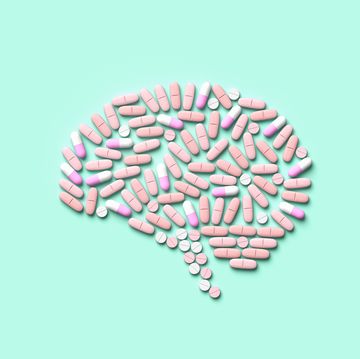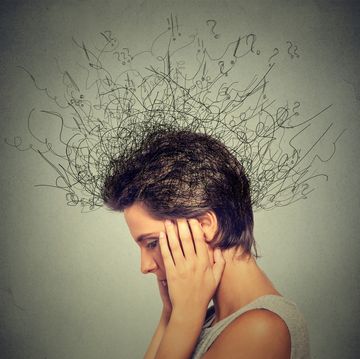About one in seven Americans experiences the throbbing, pulsing, excruciating agony of a migraine at least once a year, and it's one of the leading causes of emergency room visits in the United States. But as common as they are, many people don't even realize their intense headaches are actually migraines. Recent research shows that when someone self-diagnoses a sinus headache, it's actually a migraine a whopping 90 percent of the time.
That's why understanding migraine symptoms is so important. If you know you've been having migraines, then you can start identifying migraine triggers to avoid and know when to begin administering migraine treatment.
The 4 phases of a migraine headache
The migraine sign everyone knows is a severe headache, but there's actually more to it than that. In fact, there are four distinct stages to a migraine that can begin up to a full day before you descend into the pits of an attack. You might not go through every migraine phase every time you have one, and you may never experience some at all. Still, keep an eye out for these signs.
Phase 1: Prodrome
In the day or two before an attack, you may develop symptoms like:
- Thirstiness
- Frequent urination
- Food cravings
- Constipation
- Neck stiffness
- Mood changes
- Frequent yawning
Though these symptoms are irritating, they can serve as warning signs. This can be helpful if you’ve had migraines before and know you’ll need to take meds (either ones prescribed by your doctor, or over-the-counter drugs like Excedrin), because you'll have a better sense of when to take the medication. The faster you treat the migraine, the more effective the treatment is likely to be.
Phase 2: Aura
Roughly one out of every three migraine sufferers has an aura either just before or during the headache. It's usually a visual disturbance, and can look like “colored lights, zig-zagging patterns, dots, and prism effects that tend to shimmer or scintillate and migrate across the visual field,” says Bradley Katz, MD, a neuro-ophthalmologist at the University of Utah's Moran Eye Center who specializes in treating migraine-related light sensitivity. “There's usually a small blind spot, too. If you were driving while having a migraine aura, you'd have to pull over and wait for it to pass.”
There can also be olfactory auras, where you think you smell something bad and chemical-like, Dr. Katz says. That’s not all: “Others can suddenly become confused, have trouble speaking or thinking of words, or experience numbness or tingling on one side of the body—stroke-like symptoms." An aura might last for 20 to 60 minutes, and it tends to begin gradually and then build.
Phase 3: Attack
❗️A pulsing, throbbing headache
Migraines can sometimes be mild, but often they cause severe pain that throbs or pulses. Often, this pain occurs on only one side of the head, but sometimes it occurs on both sides. The pain can last four to 72 hours, on average, if left untreated, and it may be accompanied by blurred vision and lightheadedness or fainting. This migraine headache might be episodic and occur every now and then, or it could be chronic and happen more than 15 days out of each month for three months or more.
❗️Nausea or vomiting
If you feel queasy or toss your cookies alone with your headache, you're most likely experiencing a migraine.
❗️Hypersensitivity to lights and sounds
When you feel blinded by certain kinds of lights or sounds feel especially noisy—and all you want to do is curl up in a quiet, dark room and sleep—hello, migraine. "It's mainly non-incandescent, artificial, indoor light that irritates people with migraine," says Dr. Katz. "This could include fluorescent light bulbs, computer screens, and the type of overhead lighting you'll find in stores like Walmart, Lowe's, Home Depot, or Costco."Sometimes when a migraine hits, you can become extra-sensitive to smells and touch, too.
These telltale symptoms can be intense, which can make a migraine an especially annoying kind of headache to get. Migraines are more likely than other kinds of headaches to negatively interfere with your plans or responsibilities. For example, if you find that you can't make it through, say, attending a child's birthday party with your little one, you probably have a migraine.
Phase 4: Post-Drome
After the headache you might get something similar to a hangover (think: feeling drained, dizzy, weak, or confused).
When it comes to the sequence above (prodrome, aura, attack, and then post-drome), know that you may experience all of those stages or none—it varies from person to person. In fact, it's even possible to develop an aura and no headache. "That's far less common. It's more likely to happen as you mature. Someone might have migraine aura with headache at a younger age and then just the aura as they get older," says Wade Cooper, DO, director of the University of Michigan's Headache and Neuropathic Pain Clinic in Ann Arbor.
When to call a doctor about your migraines
If you're not getting satisfactory relief from over-the-counter medications and lifestyle changes, or if you're taking over-the-counter medications more than 10 to 15 times per month, talk to your primary care physician about your headaches.
"The evaluation of headaches usually starts with the primary care doctor, who assesses whether a patient has a common headache or something more serious," says Santiago Mazuera Mejia, MD, a neurologist at the Sandra and Malcolm Berman Brain & Spine Institute at LifeBridge Health in Baltimore, Maryland. "Primary care doctors often continue to see people with infrequent migraines. However, if at some point, there is a need for more complex treatments, patients usually go to neurologists and headache specialists who have additional training in preventive and acute treatments as well as nonmedical treatments."
It's important to get evaluated by a doctor because taking over-the-counter medications too frequently can sometimes lead to serious side effects (like liver problems) or actually make you get headaches more often.
It's helpful to keep a diary if you experience migraines because you may discover your triggers, which can inform which type of treatment is best for you. Write down what time your migraines occur, how long they last, how you slept the night before, what you ate/drank that day and when, how you felt emotionally that day, etc. Then bring that information to your doctor.
And ask your family members about the specific symptoms above to see if any of them have ever experienced migraines, since researchers believe there may be a genetic cause. Your doctor will want to know that, too. Remember, it's possible that your relatives have had migraines but just never knew what they were called. Many migraines, unfortunately, go undiagnosed and untreated. The good news is there are lots of migraine treatment options that may help you find major relief.
If you have any of the following headache symptoms, be sure to go to the emergency room immediately, because these may be signs of a more serious medical problem.
- A headache that occurs after a head injury, especially one that becomes increasingly severe
- A headache that gets worse when you cough, strain, or exert yourself
- A sudden, severe headache that feels like a thunderclap
Jane Bianchi is a writer and editor with more 13 years of experience specializing in health; she formerly worked as a health editor at Family Circle, and her work has appeared in Men’s Health, Women’s Health, Esquire, and more.













